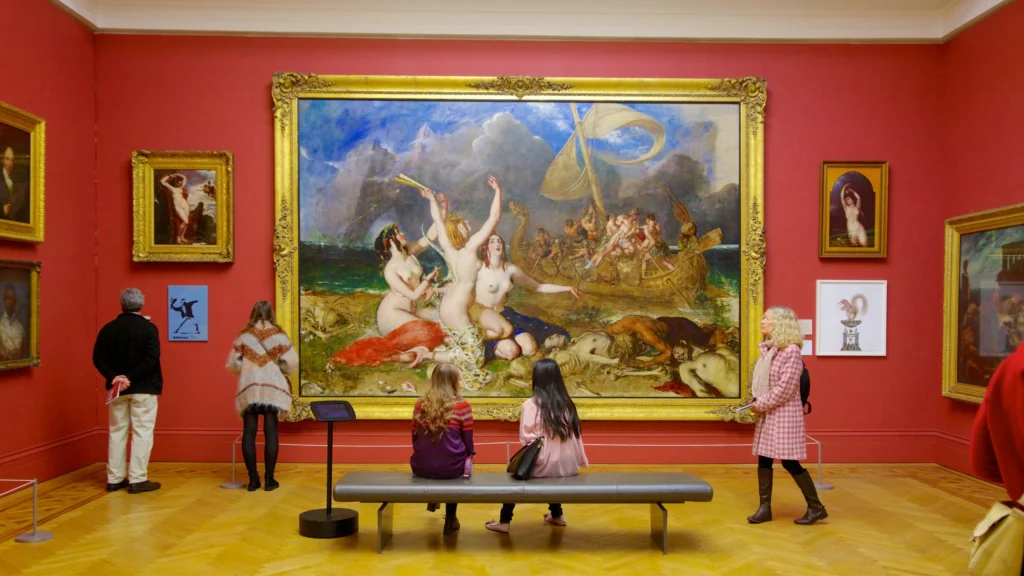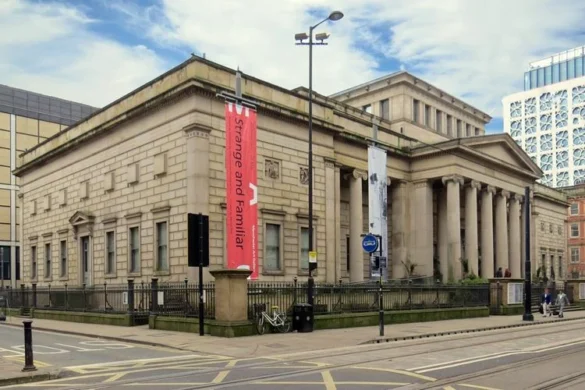Manchester Art Gallery, located in the heart of Manchester city centre, is one of the most significant cultural institutions in the United Kingdom. Renowned for its rich and diverse collection, its striking neoclassical architecture, and its role as a hub for education and community engagement, the gallery embodies both the city’s industrial past and its forward-looking cultural ambitions. For more than a century and a half, it has been a place where art, history, and society meet, offering visitors an opportunity to explore works spanning over six centuries.

Origins and Foundation
The roots of Manchester Art Gallery stretch back to the early 19th century, when Manchester was at the height of its growth as the world’s first industrial city. As wealth flowed into the city through textiles and trade, civic leaders recognized the importance of creating cultural institutions that would elevate the city’s intellectual and artistic standing.
The Royal Manchester Institution, founded in 1823, played a crucial role in this process. Established by a group of prominent industrialists and patrons, the Institution sought to promote the arts, sciences, and literature. In 1824, it commissioned the construction of a grand neoclassical building on Mosley Street, designed by Sir Charles Barry, who later became famous as the architect of the Houses of Parliament. This building became the foundation of today’s Manchester Art Gallery.
By the late 19th century, the Institution’s collection and mission were transferred to the city of Manchester, and the gallery opened as a public museum in 1882. This marked a significant step in Manchester’s cultural development, ensuring that art was accessible not just to the wealthy elite but to the wider public.
Architecture
The original gallery building on Mosley Street remains a striking example of neoclassical architecture. Designed by Sir Charles Barry, it features a symmetrical façade with imposing Corinthian columns, a portico, and finely detailed stonework. Its monumental style reflects the civic pride of Manchester’s industrial leaders, who sought to associate the city with classical ideals of beauty, order, and enlightenment.
Over time, the gallery has expanded to accommodate its growing collection. In 2002, a major renovation and extension project, designed by Michael Hopkins and Partners, connected the original Barry building with two adjacent structures, creating a unified gallery complex. The new design incorporated modern elements such as glass and steel while preserving the historical integrity of the older buildings. The redevelopment not only increased exhibition space but also provided improved facilities for education, conservation, and visitor services.
The Collection
Manchester Art Gallery houses an impressive and wide-ranging collection of more than 25,000 objects, spanning six centuries of fine art, decorative art, and design.
Fine Art
The gallery’s fine art collection is particularly renowned for its holdings in British painting from the 18th and 19th centuries. Key highlights include works by Thomas Gainsborough, George Stubbs, and J.M.W. Turner, whose landscapes and portraits illustrate the richness of British art during the Georgian and Victorian periods.
The gallery is especially celebrated for its collection of Pre-Raphaelite paintings, one of the finest in the country. Artists such as Dante Gabriel Rossetti, Ford Madox Brown, and William Holman Hunt are represented in depth. Brown’s monumental painting Work and Rossetti’s Astarte Syriaca are among the gallery’s most iconic pieces, embodying the Pre-Raphaelite movement’s fascination with beauty, symbolism, and moral themes.
In addition to British art, the gallery holds important works from European schools, including Dutch, Flemish, and French paintings. Masters such as Jacques-Louis David and Claude Monet are represented, allowing visitors to explore the development of European art alongside the British tradition.
Decorative Arts
The gallery’s collection of decorative arts is equally significant, encompassing ceramics, glass, silver, furniture, and textiles. These works highlight both the artistry of everyday objects and the craftsmanship of luxury items. Particularly strong are the holdings in 18th- and 19th-century ceramics, including pieces by Wedgwood and other leading British manufacturers.
The collection also explores the connections between art and industry, reflecting Manchester’s history as a centre of design and production. Items such as textiles and industrially produced goods illustrate the interplay between artistic creativity and the city’s industrial economy.
Modern and Contemporary Art
In the 20th and 21st centuries, Manchester Art Gallery has continued to collect actively, ensuring that its holdings remain relevant to contemporary audiences. The gallery owns works by modern British artists such as L.S. Lowry, whose depictions of industrial Manchester are particularly resonant, and Francis Bacon, known for his emotionally charged paintings.
Contemporary art is also well represented, with works by artists such as Tracey Emin, Grayson Perry, and Cornelia Parker. These pieces challenge traditional boundaries and engage with themes of identity, politics, and society, ensuring that the gallery remains at the forefront of cultural debate.
Exhibitions and Programming
Manchester Art Gallery is renowned not only for its permanent collection but also for its dynamic program of temporary exhibitions. These exhibitions bring international art to Manchester, showcase emerging talent, and explore topical issues through the lens of visual culture.
Past exhibitions have ranged from retrospectives of major figures such as Ford Madox Brown to innovative shows highlighting fashion, design, and popular culture. For example, exhibitions exploring the work of designers like Vivienne Westwood and artists addressing issues of race, gender, and identity have attracted diverse audiences and sparked critical conversations.
Alongside exhibitions, the gallery hosts a rich program of educational events, lectures, and workshops. Schools, families, and community groups regularly use the gallery’s resources, reflecting its commitment to accessibility and lifelong learning.
Civic and Social Role
As a public institution, Manchester Art Gallery plays a vital role in the city’s civic and cultural life. It is not simply a repository of art but a space for dialogue, learning, and social engagement.
Education and Outreach
The gallery’s education programs are extensive, working with schools, colleges, and universities to support arts education. Workshops, guided tours, and hands-on activities help students of all ages engage with art in meaningful ways.
The gallery also runs community outreach initiatives aimed at engaging marginalized groups. Programs for people with disabilities, mental health challenges, or those experiencing social exclusion demonstrate the gallery’s commitment to inclusivity and wellbeing.
Civic Identity
Manchester Art Gallery is central to the city’s cultural identity. Its collection of Pre-Raphaelite works and paintings by L.S. Lowry connect directly to Manchester’s industrial and social history, while its modern and contemporary holdings align the city with global artistic developments.
The gallery’s location, near St Peter’s Square and adjacent to major civic institutions, underscores its symbolic importance as part of Manchester’s cultural quarter.
Resilience and Renewal
Like much of Manchester, the art gallery has faced challenges but demonstrated resilience. During the Second World War, parts of the gallery were damaged by bombing, though many treasures were evacuated to safer locations. The post-war years saw repairs and a renewed commitment to serving the public.
The redevelopment of the gallery in the late 20th and early 21st centuries ensured that it could continue to meet the needs of modern audiences. By blending historic architecture with contemporary design, the gallery reflects Manchester’s ability to honour its past while embracing change.
Visitor Experience
Today, Manchester Art Gallery attracts hundreds of thousands of visitors each year. Admission is free, reflecting the gallery’s mission to make art accessible to all. The visitor experience combines the grandeur of historic galleries with modern amenities, including cafés, shops, and learning spaces.
The gallery is also integrated into the wider cultural life of the city. Its location makes it a natural stop for tourists exploring Manchester, while its exhibitions and events ensure a steady flow of local visitors. For many, the gallery is both a cultural landmark and a community space.
Conclusion
Manchester Art Gallery stands as one of the city’s greatest cultural achievements. From its origins in the early 19th century as part of the Royal Manchester Institution to its current role as a vibrant public museum, it reflects the values of education, creativity, and civic pride that define Manchester.
With a collection spanning six centuries, from Pre-Raphaelite masterpieces to contemporary installations, the gallery offers something for everyone. Its exhibitions, education programs, and community initiatives ensure that it remains not only a place to view art but also a space for dialogue, learning, and inclusion.
In many ways, Manchester Art Gallery embodies the spirit of the city itself: industrious, resilient, innovative, and diverse. It is not simply a gallery but a living institution that continues to inspire and engage, connecting the people of Manchester to their past, present, and future through the power of art.

